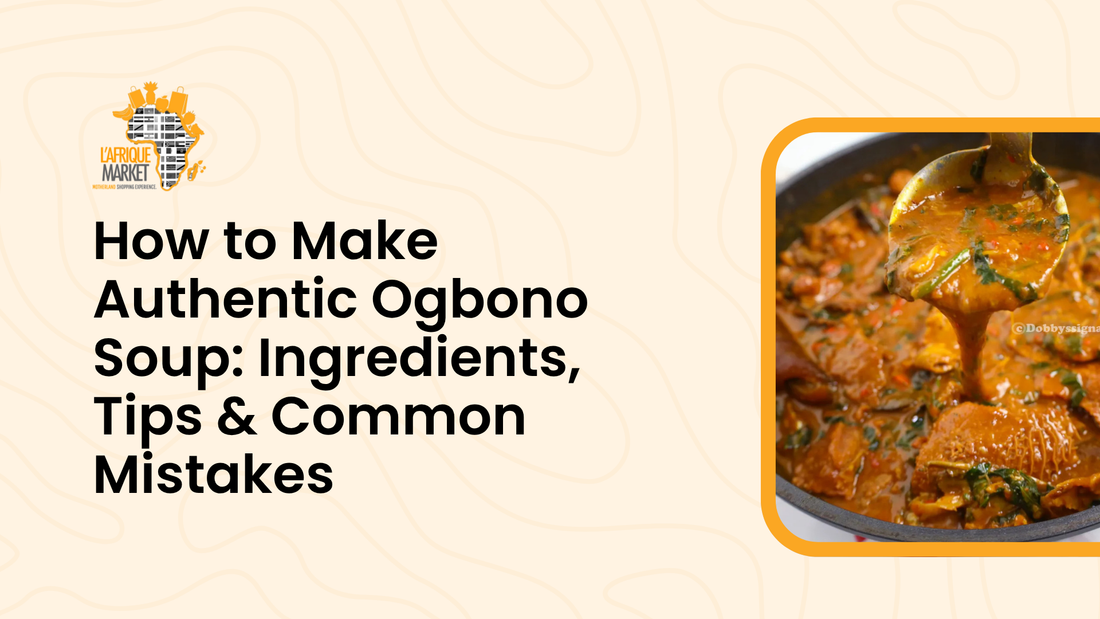
How to Make Authentic Ogbono Soup: Ingredients, Tips & Common Mistakes
Share
“Wait, why is it not drawing?”
That’s the question most people ask the first time they mess up Ogbono soup. Maybe the oil was too hot. Maybe you added too much water. Maybe your ground ogbono wasn’t even real.
I’ve been there. And if you’re from a Nigerian home, you probably have too.
Ogbono soup isn’t just another dish; it’s a texture, a taste, a memory. It’s how your auntie knew how to balance crayfish and bitterleaf just right. It's what grandma made with dry fish on slow Sunday afternoons. It's also the soup that made you almost cry the first time you tried cooking it yourself.
Let’s get it right this time.

Image from: Dobby's Signature
First Off, What Is Ogbono?
Ogbono seeds come from the African bush mango tree, and when ground and cooked right, they thicken soups in a way that makes them draw or stretch. That signature “slippery” texture? That’s the whole point.
Different tribes have their own ways of preparing it. Some people swear by bitterleaf, others won’t touch it without ugu. Some blend it smooth, others like it chunky. But one thing is universal: Ogbono soup must draw. If it doesn’t, you’ve failed.
Ingredients You Need
Here’s what you actually need:
- Ground Ogbono seeds (freshly ground, not expired!)

Image from: Udy Foods
- Palm oil – unbleached and red as your Sunday stew

- Meats – a mix of beef, cow skin, tripe, or goat

- Stockfish and/or dry fish – for that ancestral flavor

- Crayfish (ground) – don’t skip this


- Locust beans (iru) – optional but deeply flavorful

- Leafy veg – ugu, spinach, or bitterleaf

- Pepper – fresh or dried, depending on your spice level
 - Water or stock from boiled meat
- Water or stock from boiled meat
Also Read: 10 Romantic African Meals Ideas for an Unforgettable Date Night at Home
Let’s Cook: Step-by-Step
1. Boil your meats
Start with seasoning and boiling your meats. Use onions, seasoning cubes, salt. Save the stock — it’s liquid gold.
2. Melt palm oil (gently)
In another pot, melt palm oil over low heat. DO. NOT. BLEACH. This isn’t fried stew.
3. Stir in ground ogbono
Add your ogbono powder to the warm oil and stir until it’s smooth. If it’s lumpy now, it’ll stay lumpy forever.
4. Add stock gradually
Slowly pour in your meat stock while stirring. This helps the ogbono activate and draw. Too much liquid = no stretch. Balance is key.
5. Add meats & flavorings
Throw in your cooked meats, crayfish, and iru. Let it simmer. Taste and adjust your seasoning.
6. Finish with leafy greens
Add vegetables near the end. You want them cooked but still green. Don’t overdo it — Ogbono is the star here.
7. Simmer low & slow
Let everything sit on low heat until the soup thickens into that rich, glossy stretch.
Common Pitfalls (aka, What Not to Do)
- Using old or fake ogbono
If it smells like dust or doesn’t blend smoothly, toss it. L’Afrique Market only stocks the real deal.
- Overheating palm oil
You’re not making stew. Too much heat will break the ogbono and kill the draw.
- Adding water too fast
This is the #1 reason your soup turns watery. Be patient. Add stock slowly while stirring.
- Skipping the crayfish
Big mistake. Crayfish = depth. Without it, your soup will taste like boiled oil.
What to Eat Ogbono Soup With?
Take your pick:
- Pounded yam (OG pairing)
- Eba (the everyday classic)
- Semo (smooth, easy swallow)
- Fufu or amala (depending on your region)
Honestly, even rice can work if you’re a risk taker.
Ogbono soup is rich in fiber, beneficial for digestion, and surprisingly nutrient-dense. The seeds themselves are packed with fat-burning compounds and antioxidants.
A soup that has fed generations, from village kitchens to city apartments in the diaspora.
Ogbono soup doesn’t have to be intimidating. With the right ingredients and a little care, you can make a pot that tastes just like home — thick, bold, and rich in flavor.
So go ahead, make it this weekend. And don’t forget: if it doesn’t draw, it’s not Ogbono 😌
See you in the next blog.
